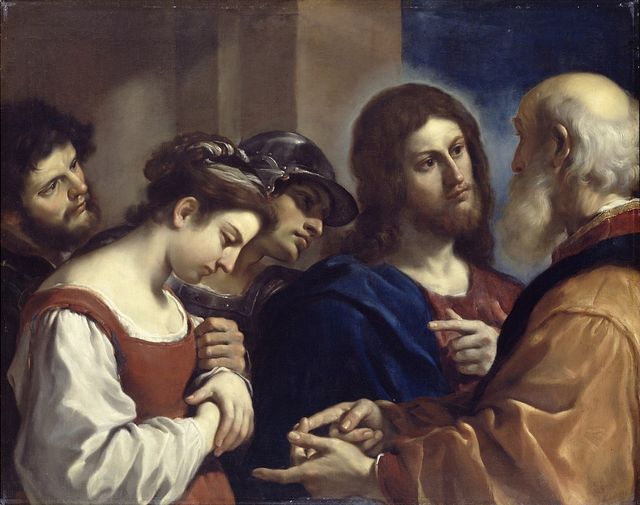
the Fifth Sunday of Ordinary Time
Gospel according to John 8:1-11
Jesus went to the Mount of Olives. But early in the morning he arrived again in the temple area, and all the people started coming to him, and he sat down and taught them. Then the scribes and the Pharisees brought a woman who had been caught in adultery and made her stand in the middle. They said to him, “Teacher, this woman was caught in the very act of committing adultery. Now in the law, Moses commanded us to stone such women. So what do you say?” They said this to test him, so that they could have some charge to bring against him. Jesus bent down and began to write on the ground with his finger. But when they continued asking him, he straightened up and said to them, “Let the one among you who is without sin be the first to throw a stone at her.” Again he bent down and wrote on the ground. And in response, they went away one by one, beginning with the elders. So he was left alone with the woman before him. Then Jesus straightened up and said to her, “Woman, where are they? Has no one condemned you?” She replied, “No one, sir.” Then Jesus said, “Neither do I condemn you. Go, and from now on do not sin any more.”

Reflections
In last week’s Gospel, the Pharisees and the Scribes challenged Jesus because He shared a meal with some tax collectors who were considered sinners. Through the parable of the Prodigal Son, Jesus explained that His mission is to lead those who have wandered away from the Father back to their spiritual home. Just as the loving Father welcomed his youngest son, who had resolved to undergo a change of heart and mind, Jesus described that the Father’s love is gentle and tender. (1) God is always near us, there to meet us first, and merciful. (2)
In this week;s Gospel the challenge continues but it goes a step further: The Pharisees and the Scribes bring a woman in front of Jesus who had been caught in the act of infidelity. Itos not just that they shun “the sinner,” they want to stone her according to the commandment of the Mosaic Law (John 8:5). Stoning in Jesus’ time was considered one form of capital punishment for most serious sinners who showed no remorse and who were caught committing repeated offences. In order to be condemned, a person was to be tried in front of a tribunal consisting of elders. Several witnesses had to testify. After being found guilty, the act of stoning was carried out ina designated field, outside of the city. The body of the deceased was formally left unburied as a sign of a curse and a warning to the community. (3)
Since the woman in question has been caught in the very act of a sinful act, she was brought in front of Jesus only to test Him and to trap Him: If he participated in condemning the woman, became part of the tribunal necessary to condemn her as a responsible member of His community, He would have shown himself cruel and unkind. If He declined to participate in condemning her, He would put Himself against the expectations of His community, and violate the Mosaic Law. It seemed like a trap with no way out for Jesus. However, in an unexpected move, Jesus did not seem to be perturbed: “...he bent down and wrote”...in the dust. (John 8:6)
They kept pushing and showing each other, eagerly anticipating the answer, while the woman was right in the middle. The moment was tense. It was a decision between life and death. What could have kept Jesus’ attention, writing in the dust? What was worth writing in the dust of the earth? According to Thomas Aquinas, Jesus’ gesture of stooping down represents God’s mercy of reaching out to human beings to lift them up (Aquinas, 2010). Jesus’ writing is like the finger of God, who carved the Ten Commandments into the granite tablets of Mount Sinai. (Aquinas, 2010). We can presume that Jesus focuses on the First commandment, and the Second one like it: “Love your God with all your heart…. [and] love your neighbor as yourself” (Matthew, 22:37-40). But St. Thomas goes even further, and explains that Jesus’ finger drawing in the dust signifies the mystery of the Incarnation–when by the finger of God, the Holy Spirit, the eternal Word waa written into our human nature, as Isaiah the prophet exclaimed:”Let the Heavens rein down the Just One and the earth bring forth a Savior.” (Aquinas 2010). –And the Savior’s “name” is Mercy. (6) Yes the woman deserved a punishment, but mercy was granted to her through the Incarnation,” stated St. Thomas, and “Therefore, there is mercy for sinners.” (Aquinas, 2010)
This mystery is shrouded in silence between Jesus and the woman and deafened by the cacophony of the mob, until Jesus straightened out and pronounced His judgement as the Messiah, the Incarnate Son of God: “Let anyone among you who is without sin be the first to cast a stone at her” (Luke 8:7). To which the voices lowered, the arms went lame, and one by one, the accusers departed, “...beginning with the elders” (Lukas 8:9). And Jesus went back to drawing in the dirt, as if “lightly recording their sins ... .so that they can be wiped away easily if only they will accept that they need the mercy of God.” (4) The law of mercy was now written in the hearts. The elders, who “grew old in their sins” (Dan 13:51), left first, as they did not want their sins to become open in public; they did not want forgiveness and mercy from Jesus.
Thus, Jesus was left alone with the woman, a symbol of all humanity. He stood up straight for the second time, and dismissed her in peace with the words, “Go your way, and from now on, do not sin again” (Luke 8:11). His words convey God’s grace and mercy for all for all humanity. Those who find refuge in the Lord are now free from any accusation or guilt. (4)
How should this relate to how we treat others? Perhaps we could close our reflection by pondering the words of Saint Teresa of Calcutta: “ I am most unworthy. But I brought a girl child from the street, and I could see in the face of the child that she was hungry. God knows how many days she has not eaten. So I gave her a piece of bread and the little one started eating the bread, crumb by crumb. And I said, ‘Eat!’ I said to the child, ‘Eat the bread! Eat the bread!’ And she looked at me and said, ‘I am afraid to eat the bread because I am afraid that when it is finished, I will be hungry again.’ This is a reality. Maybe we are not hungry for a piece of bread, but maybe there is somebody there in the family who is unwanted, unloved, unfed, forgotten. And there is love. Love begins at home. And for love to be true, it has to hurt. And this is what I bring before you: Love one another with great love.” (7)
Sources:
Santucci, M. (2023). Pope at Angelus: By loving others, ‘we reflect the Father;s love like mirrors.’ Retrieved from: www. ewtnvatican.com Accessed on: March 3, 2025.
Glatz, C. (2025). God’s mercy is for everyone; everyone needs healing, pope writes. Retrieved from: usccb.org. Accessed: Marsh 3, 2025
Bar, S. (2021). Death by Stoning in the Hebrew Bible and in Post-Biblical Traditions. Old Testament Essays. University of Memphis. Retrieved from: www. scielo.org.za Accessed: March 3, 2025.
Walshe, S. (2020). Mysteries Revealed: Jesus and the Woman Caught in Adultery. Retrieved from: www.shop.catholic.com Accessed: March 3, 2025
St. Thomas Aquinas (1841,2010). Catena Aurea (The Golden Chain). The Gospel of Luke. Translated by John Henry Newman. Turnhout: Brepols Publishers.
Rossmann, M. (2016). The Name of God is Mercy–Review. The Jesuit Post. Retrieved from: www.thejesuitpost.org. Accessed: March 3, 2025.
St. Mother Teresa of Calcutta (1979). Nobel Peace Prize Acceptance Speech at the University of Oslo, Oslo, Norway on December 10, 1979. Retrieved from: Nobelprize.org Accessed: March 3, 2025.